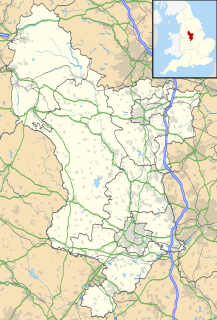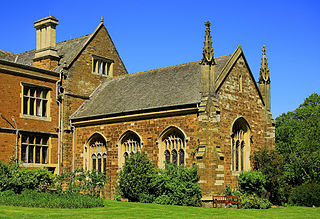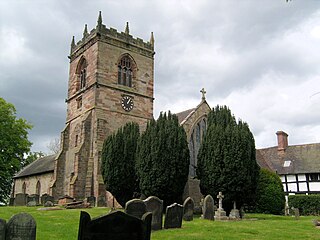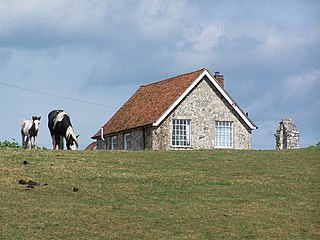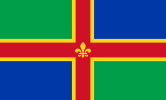Hough Priory was a priory in Hough-on-the-Hill, Lincolnshire, England. The manor on which the priory of Hough was afterwards built was granted by Henry I to his abbey of St. Mary de Voto at Cherbourg, for Austin canons. The parent abbey itself at its foundation contained only an abbot and four canons, and the cell having no other endowment than the manor and church of Hough, was intended for the support of a prior with a single chaplain for his companion, to maintain divine service for the soul of the king and his family. [1]

Hough-on-the-Hill is a village and civil parish in the South Kesteven district of Lincolnshire, England. The population of the civil parish including Brandon was 399 at the 2011 census. It is situated approximately 7 miles (11 km) due north from the market town of Grantham. The hamlets of Gelston and Brandon are part of the parish. Hough-on-the-Hill is on a significant rise, hence the name.
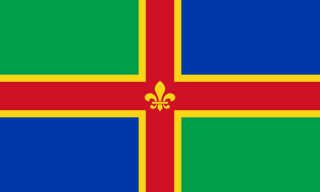
Lincolnshire is a county in eastern England, with a long coastline on the North Sea to the east. It borders Norfolk to the south east, Cambridgeshire to the south, Rutland to the south west, Leicestershire and Nottinghamshire to the west, South Yorkshire to the north west, and the East Riding of Yorkshire to the north. It also borders Northamptonshire in the south for just 20 yards (18 m), England's shortest county boundary. The county town is the city of Lincoln, where the county council has its headquarters.

England is a country that is part of the United Kingdom. It shares land borders with Wales to the west and Scotland to the north-northwest. The Irish Sea lies west of England and the Celtic Sea lies to the southwest. England is separated from continental Europe by the North Sea to the east and the English Channel to the south. The country covers five-eighths of the island of Great Britain, which lies in the North Atlantic, and includes over 100 smaller islands, such as the Isles of Scilly and the Isle of Wight.
The prior was at first bound to send a fixed sum of money to Cherbourg every year; after the beginning of the Hundred Years' War (1337-1453) this pension was transferred to the Exchequer. Early in the fourteenth century the assistant chaplain was withdrawn, as the revenue was not sufficient to support two canons any longer, and in 1340, the prior himself was reduced to such straits that he had to beseech Edward III of England for remission of his arrears, amounting to 55 marks. An inquisition of the property was taken in 1349, when it was again found almost impossible to pay the pension appointed. The priory mill had become broken and useless, and nearly all the trees had been cut down; indeed, almost everything of value in the house had been sold to supply the money due to the Exchequer. [1] Most of the chantries founded in the priory church had lapsed, as the prior could not serve them all by himself. [1]

The Hundred Years' War was a series of conflicts waged from 1337 to 1453 by the House of Plantagenet, rulers of the Kingdom of England, against the French House of Valois, over the right to rule the Kingdom of France. Each side drew many allies into the war. It was one of the most notable conflicts of the Middle Ages, in which five generations of kings from two rival dynasties fought for the throne of the largest kingdom in Western Europe. The war marked both the height of chivalry and its subsequent decline, and the development of strong national identities in both countries.

Edward III was King of England and Lord of Ireland from January 1327 until his death; he is noted for his military success and for restoring royal authority after the disastrous and unorthodox reign of his father, Edward II. Edward III transformed the Kingdom of England into one of the most formidable military powers in Europe. His long reign of 50 years was the second longest in medieval England and saw vital developments in legislation and government, in particular the evolution of the English parliament, as well as the ravages of the Black Death.
The priory was restored to the abbey of Cherbourg in 1399, but finally granted to the Carthusians of Mountgrace in 1432, (fn. 6) and confirmed to them by Edward IV of England in 1462. [1]

Edward IV was the King of England from 4 March 1461 to 3 October 1470, and again from 11 April 1471 until his death. He was the first Yorkist King of England. The first half of his rule was marred by the violence associated with the Wars of the Roses, but he overcame the Lancastrian challenge to the throne at Tewkesbury in 1471 to reign in peace until his sudden death. Before becoming king, he was Duke of York, Earl of March, Earl of Cambridge and Earl of Ulster.
The revenue of the priory was valued in 1388 at £38 8s. 8d. [1]






